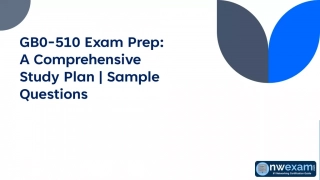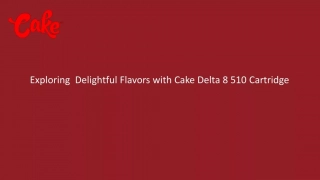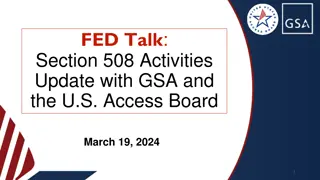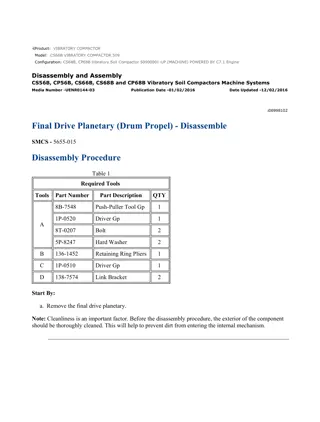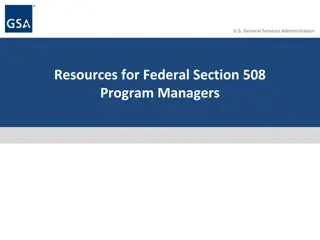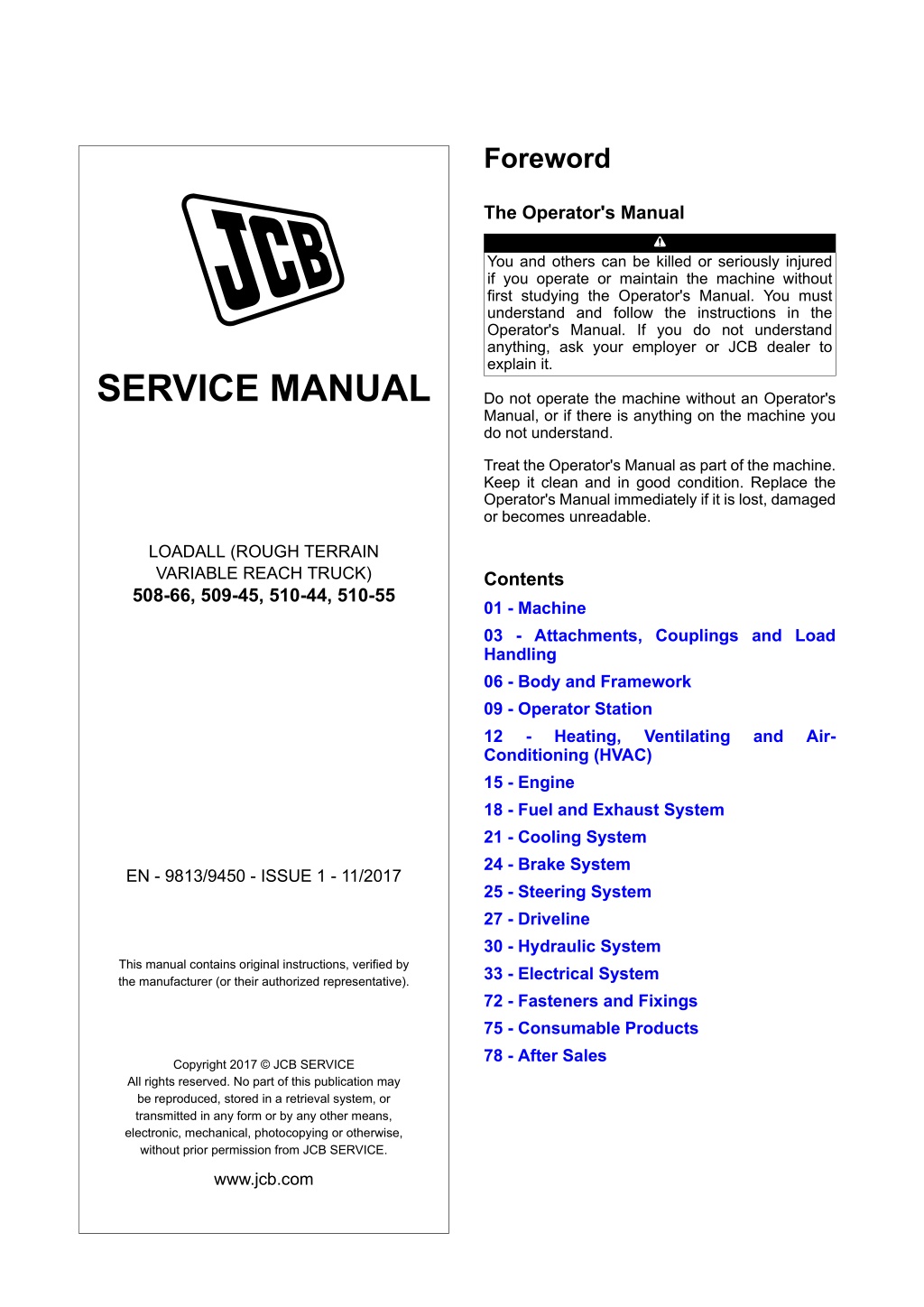
JCB 508-66, 509-45, 510-44, 510-55 Telescopic Handler Service Repair Manual Instant Download (SN 2902000 and up)
Please open the website below to get the complete manualnn//
Download Presentation

Please find below an Image/Link to download the presentation.
The content on the website is provided AS IS for your information and personal use only. It may not be sold, licensed, or shared on other websites without obtaining consent from the author. Download presentation by click this link. If you encounter any issues during the download, it is possible that the publisher has removed the file from their server.
E N D
Presentation Transcript
Foreword The Operator's Manual You and others can be killed or seriously injured if you operate or maintain the machine without first studying the Operator's Manual. You must understand and follow the instructions in the Operator's Manual. If you do not understand anything, ask your employer or JCB dealer to explain it. SERVICE MANUAL Do not operate the machine without an Operator's Manual, or if there is anything on the machine you do not understand. Treat the Operator's Manual as part of the machine. Keep it clean and in good condition. Replace the Operator's Manual immediately if it is lost, damaged or becomes unreadable. LOADALL (ROUGH TERRAIN VARIABLE REACH TRUCK) 508-66, 509-45, 510-44, 510-55 Contents 01 - Machine 03 - Attachments, Couplings and Load Handling 06 - Body and Framework 09 - Operator Station 12 - Heating, Ventilating Conditioning (HVAC) 15 - Engine 18 - Fuel and Exhaust System 21 - Cooling System 24 - Brake System 25 - Steering System 27 - Driveline 30 - Hydraulic System 33 - Electrical System 72 - Fasteners and Fixings 75 - Consumable Products 78 - After Sales and Air- EN - 9813/9450 - ISSUE 1 - 11/2017 This manual contains original instructions, verified by the manufacturer (or their authorized representative). Copyright 2017 JCB SERVICE All rights reserved. No part of this publication may be reproduced, stored in a retrieval system, or transmitted in any form or by any other means, electronic, mechanical, photocopying or otherwise, without prior permission from JCB SERVICE. www.jcb.com
15 - Engine 09 - Bedplate 00 - General 00 - General Introduction Introduction .................................................... 15-63 Remove and Install ....................................... 15-64 The bedplate acts as the main strength component of the engine. it maintains the correct alignment and supports the weight of the internal components. Figure 219. 1 2 1 Bedplate 2 Crankcase 15 - 63 9813/9450-1 15 - 63
15 - Engine 09 - Bedplate 00 - General Remove and Install Special Tools Description Template for Sealant Bedplate to Crankcase (4 Cyl) Torque Wrench (10-100Nm) 10. Remove the rocker assembly including the push rods, refer to (PIL 15-42). Part No. 892/12356 Qty. 1 11. It is not necessary to remove the cylinder head assembly to remove the crankshaft. If however the cylinder head needs to be removed for other reasons (for piston and connecting rod removal for example) remove it now, refer to (PIL 15-06). 993/70111 1 12. Remove the fuel injection pump, refer to (PIL 18-18). Consumables Description Cleaner/Degreaser - General purpose solvent based parts cleaner Part No. 4104/1557 Size 0.4L 13. Remove the starter motor, refer to (PIL 15-75). 14. Remove the high duty PTO (Power Take-Off) device (if installed). 15. Position the engine upside down in a suitable jig or fixture, supported at the front of the cylinder block. CAUTION This component is heavy. It must only be removed or handled using a suitable lifting method and device. 16. Remove the flywheel, refer to (PIL 15-54). Before Removal 17. Remove the flywheel housing, refer to (PIL 15-54). 1. This procedure requires service parts. Make sure you have obtained the correct service parts before you start, refer to Parts Catalogue. 18. Remove the fuel injection pump drive gear, refer to (PIL 15-51). 2. Make sure that the engine is safe to work on. If the engine has been running, let it cool before you start the service work. 19. Remove the oil pump, refer to (PIL 15-60). 20. Remove the high duty PTO idler drive gear (if installed), refer to (PIL 15-51). 3. Remove the engine, refer to (PIL 15-00). 21. Remove the crankshaft drive gear, refer to (PIL 15-51). 4. Remove the drive belt, refer to (PIL 15-18). 5. Remove the crankshaft pulley, refer to (PIL 15-12). 22. Remove the camshaft, refer to (PIL 15-15). 23. Remove the rear timing case, refer to (PIL 15-51). 6. Remove the oil sump, refer to (PIL 15-45). 7. Disconnect and remove the fuel pipes from the injectors, refer to (PIL 18-96). 24. If the pistons and connecting rods have not been removed, undo and remove the main bearing caps, refer to (PIL 15-12). 8. Remove the rocker cover, refer to (PIL 15-42). 9. Remove the fuel injectors, refer to (PIL 18-18). 15 - 64 9813/9450-1 15 - 64
https://www.ebooklibonline.com Hello dear friend! Thank you very much for reading. Enter the link into your browser. The full manual is available for immediate download. https://www.ebooklibonline.com
15 - Engine 09 - Bedplate 00 - General Figure 220. 5 1 4 11 9 8 10 7 6 2 3 P3 X 18 12 18 18 18 18 13 18 1-10 12 18 T1 Main bearing bolts (x10) Bedplate Upper bearing shell (x5) Lifting bolts (obtain locally) 11 13 P3 Bedplate peripheral bolts (x16) Crankcase O-ring (if installed) 15 - 65 9813/9450-1 15 - 65
15 - Engine 09 - Bedplate 00 - General Remove suitable lifting equipment (if the bedplate is lifted manually, two people will be required). DO NOT use a lever to separate the bedplate. 1. Remove the bedplate peripheral bolts. 2. Progressively remove the main bearing bolts in reverse order starting at bolt 10. The bolts MUST NOT be re-used. Discard the bolts. 4. Remove and discard the O-ring. 5. Carefully remove the upper bearing shells from the bedplate, remove the bedplate. 3. Install the four temporary lifting bolts. Carefully separate the bedplate from the crankcase. Use Figure 221. P2 T4 Y Y A (T5) V T4 P2 P3 B (T5) P2 Y Y T6 18 18 18 X 18 T6 5 18 1 4 T6 11 9 8 W 18 12 T6 10 7 6 2 3 13 1-10 12 18 B Main bearing bolts Bedplate Lower bearing shells (x5) Right side template 11 13 A T3 Bedplate peripheral bolts (x16) Crankcase Left side template Angle Gauge (obtain locally) 15 - 66 9813/9450-1 15 - 66
15 - Engine 09 - Bedplate 00 - General T4 T6 W Y P3 Guide pins (x2 obtain locally) Lifting bolts (x4 obtain locally) Bearing tab Bearing location tab O-ring T5 V X P2 Sealant template Sealant template portion for removal Rear main bearing Anaerobic sealant 15 - 67 9813/9450-1 15 - 67
15 - Engine 09 - Bedplate 00 - General Before Installation as a guide apply beads of sealant P2 around the crankcase/bedplate mating face as shown to the dimension specified. Length/Dimension/Distance: 1.5mm 1. Clean off all traces of the old sealant compound from the crankcase and bedplate mating faces. 2. Use a suitable degreasing agent to carefully clean the main bearing saddles in the bedplate and crankcase. Take care not to block the oil ways or the piston cooling jets. Consumable: Cleaner/Degreaser - General purpose solvent based parts cleaner 9. Remove the four fixing bolts at positions Y. Remove the templates A and B, make sure you do not smudge the sealant. Discard the templates. 10. Add beads of sealant P2 around the four bolt holes at positions Y, so as to join the sealant beads as shown at X. Important: Anaerobic sealant will not start to cure whilst it is open to the atmosphere, however when air is excluded (for instance when the two parts are put together) it will immediately start to harden. Make sure that all the necessary tools, bolts etc. are readily available prior to assembling the components. The parts must be installed and tightened to the correct torque value within 5 minutes (with a maximum permissible time of 15 minutes). 11. Make sure that the location guide pins T4 are in position in the crankcase. Assemble the bedplate to the crankcase use the alignment guide pins. 12. Note: The bedplate is heavy. Two people will be required to lift and rotate the bedplate safely on to the crankcase. Install new main bearing bolts 1-10. Tighten the bolts to the correct torque value in pairs, starting in the centre and working outwards (in sequence 1-10) to the 1st stage pre- torque. Special Tool: Torque Wrench (10-100Nm) (Qty.: 1) Important: BEFORE installing the bedplate: DO NOT rotate the crankshaft. Make sure that the upper main bearing shells are flush with the bottom face of the crankcase. Install 13. Install the bedplate peripheral bolts. Tighten the bolts to the correct torque value. 1. The installation procedure is the opposite of the removal procedure. Additionally do the following steps. 14. After installation and tightening the bedplate peripheral bolts, further tighten the main bearing bolts in pairs, starting in the centre and working outwards (in sequence 1-10) to the 2nd stage pre-torque. 2. Make sure that all items are clean and free from damage and corrosion. 3. Install the two guide pins T4 to the crankcase bedplate fixing holes as shown. 15. Finally, angle tighten the main bearing bolts in pairs, starting in the centre and working outwards (in sequence 1-10) for the final stage torque. Use the torque and angle method, refer to Fasteners and Fixings, General, Introduction (PIL 72-00). 4. Install the four lifting bolts T6 to the bedplate as shown. 5. Install a new O-ring at the bedplate. Important: If the parts have not been tightened to the correct torque value within the maximum 15 minute time period, then the parts must be separated, thoroughly cleaned and fresh sealant applied. 6. Use a suitable degreasing agent to clean both sides of the lower bearing shells. Assemble the lower bearing shells into the bedplate. Lubricate the lower bearing shells with clean engine oil. Note: Make sure that the location tab W engages in the slot as shown. Consumable: Cleaner/Degreaser - General purpose solvent based parts cleaner After Installation 1. Check that the crankshaft can be freely rotated by hand. Remove the bedplate lifting bolts T6. 2. Carry out the procedures listed, Before removal in reverse order. 7. Note: The sealant template T5 is used on the crankcase, NOT the bedplate. The sealant template T5 comprises of two pieces, A and B. Modify the template A by removing portion V. Special Tool: Template for Sealant Bedplate to Crankcase (4 Cyl) (Qty.: 1) Table 77. Torque Table Item 1-10 (1st Stage) 1-10 (2nd Stage) Torque Value 50N m 115N m 8. Locate the holes in the templates A and B using four fixing bolts at positions Y. Use the templates 15 - 68 9813/9450-1 15 - 68
15 - Engine 12 - Crankshaft 00 - General 00 - General Introduction For: JCB T4F 4.4 over 55kw Electronic Dieselmax Turbocharged Aftercooled Engine, JCB Tier 4F Engine 4 Cyl, JCB Tier 4i /T4F <55kW Engine 4 Cyl ...... Page 15-71 Otherwise .................................. Page 15-71 Introduction .................................................... 15-71 Technical Data ............................................... 15-72 Component Identification ............................... 15-73 Operation ....................................................... 15-74 Check (Condition) .......................................... 15-75 Remove and Install ....................................... 15-76 (For: JCB T4F 4.4 over 55kw Electronic Dieselmax Turbocharged Aftercooled Engine, JCB Tier 4F Engine 4 Cyl, JCB Tier 4i /T4F <55kW Engine 4 Cyl) Figure 222. B A A Crankcase B Crankshaft (Otherwise) The crankshaft is housed inside the crankcase. It is connected to the piston via a connecting rod, they form a simple mechanism that converts reciprocating motion into rotating motion. Refer to: PIL 15-00-00. 15 - 71 9813/9450-1 15 - 71
15 - Engine 12 - Crankshaft 00 - General Technical Data Table 78. Main bearing journal diameter (x4) - min - max Main rear bearing journal diameter (x1) - min - max Connecting rod bearing journal diameter - min - max Maximum wear and ovality on journals Crankshaft induction hardness Thrust washer width - min - max Crankshaft end float - min - max (1) No visible damage/wear or marks 87.98mm 88mm 99.98mm 100mm 72.98mm 73mm (1) 55 HRc min on surface 2.44mm 2.5mm 0.05mm 0.28mm 15 - 72 9813/9450-1 15 - 72
15 - Engine 12 - Crankshaft 00 - General Component Identification Figure 223. B A A Crankcase B Crankshaft 15 - 73 9813/9450-1 15 - 73
15 - Engine 12 - Crankshaft 00 - General Operation Lubrication transfer to cross drillings in the crankshaft to feed each of the big end bearings. Crankshaft gear is 'splash' lubricated. Front and rear crankshaft oil seals prevent oil leakage from, and dirt ingress to, the engine. Oil is fed from the main gallery via five drillings, one to each of the main bearings. A groove around the diameter of the upper main bearing shell allows oil Figure 224. 1 Main gallery 3 Main bearings 5 Cross drillings 7 Crankshaft oil seal 2 Drillings (x5) 4 Big end bearings 6 Crankshaft gear 8 Crankshaft oil seal 15 - 74 9813/9450-1 15 - 74
15 - Engine 12 - Crankshaft 00 - General Check (Condition) Figure 227. 1. Check the main bearing surfaces for damage and excessive wear. Figure 225. C D A C J-jets D Fixing screws A Main bearing shells 2. Measure the crankshaft diameters to confirm they are within service limits, refer to Technical Data (PIL 15-12). Figure 226. B B Crankshaft 3. Check that the oil-way cross drillings in the crankshaft are clear and free from debris. Blocked or restricted oil-ways will cause oil starvation at the big end bearings. 4. Check that the piston cooling J-jets are clear. If the J-jets cannot be cleared remove the fixing screws. Remove theJ-jets and discard them. 5. Install new J-jets. 15 - 75 9813/9450-1 15 - 75
15 - Engine 12 - Crankshaft 00 - General Remove and Install Consumables Description Cleaner/Degreaser - General purpose solvent based parts cleaner reasons (for piston and connecting rod removal for example) remove it now, refer to (PIL 15-06). Part No. 4104/1557 Size 0.4L 12. Remove the fuel injection pump, refer to (PIL 18-18). 13. Remove the starter motor, refer to (PIL 15-75). 14. Remove the high duty PTO device (if installed). CAUTION This component is heavy. It must only be removed or handled using a suitable lifting method and device. 15. Position the engine upside down in a suitable jig or fixture, supported at the front of the cylinder block. Before Removal 16. Remove the flywheel, refer to (PIL 15-54). 1. This procedure requires service parts. Make sure you have obtained the correct service parts before you start, refer to Parts Catalogue. 17. Remove the flywheel housing, refer to (PIL 15-54). 18. Remove the fuel injection pump drive gear, refer to (PIL 15-51). 2. Make sure that the engine is safe to work on. If the engine has been running, let it cool before you start the service work. 19. Remove the oil pump, refer to (PIL 15-60). 3. Remove the engine, refer to (PIL 15-00). 20. Remove the high duty PTO idler drive gear (if installed), refer to (PIL 15-51). 4. Remove the drive belt, refer to (PIL 15-18). 21. Remove the crankshaft drive gear, refer to (PIL 15-51). 5. Remove the crankshaft pulley, refer to (PIL 15-12). 22. Remove the camshaft, refer to (PIL 15-15). 6. Remove the oil sump, refer to (PIL 15-45). 23. Remove the rear timing case, refer to (PIL 15-51). 7. Disconnect and remove the fuel pipes from the injectors, refer to (PIL 18-96). 24. If the pistons and connecting rods have not been removed, undo and remove the main bearing caps, refer to (PIL 15-12). 8. Remove the rocker cover, refer to (PIL 15-42). 9. Remove the fuel injectors, refer to (PIL 18-18). 25. Remove the bedplate, refer to (PIL 15-09). 10. Remove the rocker assembly including the push rods, refer to (PIL 15-42). Remove 11. It is not necessary to remove the cylinder head assembly to remove the crankshaft. If however the cylinder head needs to be removed for other 1. Remove the thrust washers between the crankshaft and crankcase rear main bearing. 15 - 76 9813/9450-1 15 - 76
15 - Engine 12 - Crankshaft 00 - General Figure 228. B A A C A Thrust Washers C Rear main bearing B Crankshaft Before Installation 2. Put labels on the thrust washers to make sure that they are installed in the correct positions during assembly. 1. Clean off all traces of the old sealant compound from the crankcase and bedplate mating faces. 3. Use suitable lifting equipment to carefully lift the crankshaft from the crankcase (if the crankshaft is lifted manually, two people will be required). 2. Use a suitable degreasing agent to carefully clean the main bearing saddles in the bedplate and crankcase. Take care not to block the oil ways or the piston cooling jets. Consumable: Cleaner/Degreaser - General purpose solvent based parts cleaner 4. Carefully lift out the bearing shells. Figure 229. D Important: Cleanliness is of the utmost importance. Blocked oil-ways or oil jets will cause engine failure. Before you install the crankshaft make sure that ALL oil-ways and jets are clear and free from debris. Install 1. The installation procedure is the opposite of the removal procedure. Additionally do the following steps. 2. Make sure that all items are clean and free from damage and corrosion. 3. If removed or a new crankcase is being installed then install cooling J jets as follows: D Main bearing shells 5. It is recommended that the bearing shells are replaced. If however they are to be used again, put label on the shells to make sure that they are installed in their original positions during assembly. 6. Inspect the crankshaft and main bearings etc. for damage and excessive wear. Refer to Check Condition (PIL 15-12). 15 - 77 9813/9450-1 15 - 77
15 - Engine 12 - Crankshaft 00 - General Figure 230. Figure 231. G D E F D Main bearing shells G Bearing location tab E J jets (x4) F Fixing screws 4.1. Use a suitable degreasing agent to make sure that the surface of the upper bearing shells are clean. Consumable: Cleaner/Degreaser - General purpose solvent based parts cleaner 3.1. Insert the cooling jets into the crankcase. 3.2. Note: There are different types of cooling jets installed depending on the engine application. The jets are colour coded. 4.2. Assemble the bearing shells into the crankcase bearing saddles. Make sure that the location tab engages into the slot as shown. 3.3. Be sure to install the correct jets. Refer to the relevant parts catalogue for the correct cooling jet identification. 4.3. Important: Make sure that the oil-way holes in the bearing saddles align with the holes in the bearing shell. If the holes are even partially misaligned the piston cooling oil jet will be restricted, causing the engine to fail. 3.4. Tighten the retaining screws to the correct torque value. 4. Install the upper bearing shells as follows: 4.4. Lubricate the upper bearing shells with clean engine oil. 5. Use suitable lifting equipment (if the crankshaft is lifted manually, two people will be required), to carefully lower the crankshaft into the crankcase. DO NOT rotate the crankshaft, the bearing shells can become dislodged, refer to step 4. 6. Install the thrust washers as follows: 15 - 78 9813/9450-1 15 - 78
15 - Engine 12 - Crankshaft 00 - General Figure 232. A B H A A C A Thrust washers C Rear main bearing B Crankshaft H Oil slot - thrust washers 6.1. Slide the thrust washers between the crankshaft and the crankcase rear main bearing. 6.2. Make sure that they are installed in the correct positions, with the two slots facing outwards from the bearing saddle. 6.3. If necessary, push the crankshaft forward and then backwards to obtain clearance to install the thrust washers. 6.4. DO NOT rotate the crankshaft, the bearing shells can become dislodged, refer to step 4. 7. Check that the crankshaft end float is within service limits, refer to Technical Data (PIL 15-12). Table 79. Torque Values Item F Nm 24 15 - 79 9813/9450-1 15 - 79
15 - Engine 12 - Crankshaft 03 - Main Bearing 03 - Main Bearing Introduction Introduction .................................................... 15-80 Check (Condition) .......................................... 15-81 Remove and Install ....................................... 15-81 In a piston engine, the main bearings are the bearings on which the crankshaft rotates. The bearings hold the crankshaft in place and prevent the forces created by the piston and transmitted to the crankshaft by the connecting rods from dislodging the crankshaft, instead forcing the crank to convert the reciprocating movement into rotation. Figure 233. A B A Main bearing B Crankshaft 15 - 80 9813/9450-1 15 - 80
15 - Engine 12 - Crankshaft 03 - Main Bearing Check (Condition) Remove and Install Refer to: PIL 15-12-00. 1. Check the bearing shell surfaces for signs of damage and excessive wear. 2. Measure the crank pin diameters to confirm they are within service limits. Refer to: PIL 15-12-00. 3. Renew any parts that are worn or not within the specified tolerances. 15 - 81 9813/9450-1 15 - 81
15 - Engine 12 - Crankshaft 06 - Front Oil Seal 06 - Front Oil Seal Remove and Install Special Tools Description Crankshaft Front Oil Seal Installation Tool Figure 234. Part No. 892/01157 Qty. 1 C B Before Removal 1. This procedure requires service parts. Make sure you have obtained the correct service parts before you start, refer to Parts Catalogue. 2. Make sure that the engine is safe to work on. If the engine has been running, let it cool before you start the service work. A 3. Get access to the engine. 4. Remove the drive belt, refer to (PIL 15-18). 5. Remove the crankshaft pulley, refer to (PIL 15-12-12). A Crankshaft oil seal B Crankcase C Crankshaft hub Remove 1. Use a suitable lever behind the lip of the seal, carefully prise out the oil seal from the counterbore in the crankcase. Take care not to scratch or damage the counterbore or the crankshaft hub. Damaged or dirty sealing faces will cause the oil seal to fail. Install 1. Make sure that the counterbore and the crankshaft hub are clean and free from damage and corrosion. Use a suitable degreasing agent to clean all traces of oil and grease from the counterbore. Important: The oil seal has a special coating and MUST be installed dry without lubricant. 2. Dismantle the seal installation tool. Bolt the centre body to the crankshaft hub, using the bolts. Refer to Figure 235. Special Tool: Crankshaft Front Oil Seal Installation Tool (Qty.: 1) 3. Install the oil seal on to the centre body. Make sure that the seal is installed the correct way around. Assemble the outer sleeve on to the centre body and install the screw. Refer to Figure 235. 15 - 82 9813/9450-1 15 - 82
15 - Engine 12 - Crankshaft 06 - Front Oil Seal Figure 235. B F D A G G E H F C A Crankshaft oil seal C Crankshaft hub E Fixing bolts (x3) G Outer sleeve B Crankcase D Seal installation tool F Centre body H Screw 4. Turn the screw to push the seal squarely into the counterbore until the outer sleeve comes up against the front edge of the counterbore. When correctly installed, the front face of the seal should be flush with the edge of the counterbore within the specified tolerance. Refer to Figure 236. Dimension: -0.5 -0/+0.5mm Figure 236. B A G F C A Crankshaft oil seal B Crankcase C Crankshaft hub F Centre body G Outer sleeve 5. Remove the seal installation tool. 15 - 83 9813/9450-1 15 - 83
15 - Engine 12 - Crankshaft 06 - Front Oil Seal After Installation 1. Install the crankshaft pulley, refer to (PIL 15-12-12). 2. Install the drive belt, refer to (PIL 15-18). 15 - 84 9813/9450-1 15 - 84
15 - Engine 12 - Crankshaft 09 - Rear Oil Seal 09 - Rear Oil Seal Remove and Install Special Tools Description Crankshaft Rear Oil Seal Installation Tool Crankshaft Rear Oil Seal Alignment Tool Figure 238. 15mm Hub Part No. 892/01156 Qty. 1 A 892/01158 1 B Note: The flywheel hub and crankshaft rear oil seal need to be replaced as a pair. Before Removal 1. This procedure requires service parts. Make sure you have obtained the correct service parts before you start, refer to Parts Catalogue. 2. Make sure that the engine is safe to work on. If the engine has been running, let it cool before you start the service work. C E A Crankshaft rear oil seal B Flywheel housing C Flywheel hub E Fixing bolt 3. Get access to the engine. 4. Remove the flywheel, refer to (PIL 15-54). Remove Install (24mm Hub) 1. Use a suitable lever behind the lip of the seal to carefully prise out the rear oil seal from the counterbore in the flywheel housing. Take care not to scratch or damage the counterbore or the flywheel hub. Damaged or dirty sealing faces will cause the oil seal to fail. 1. Make sure that the counterbore and the flywheel hub are clean and free from damage and corrosion. Figure 237. 24mm Hub A C B A Crankshaft rear oil seal B Flywheel housing C Flywheel hub 15 - 85 9813/9450-1 15 - 85
Suggest: If the above button click is invalid. Please download this document first, and then click the above link to download the complete manual. Thank you so much for reading
15 - Engine 12 - Crankshaft 09 - Rear Oil Seal Figure 239. B D A C D A Crankshaft rear oil seal C Flywheel hub B Flywheel housing D Oil seal alignment tool 2. To prevent the seal lip rolling over and becoming damaged, make sure that you use the oil seal alignment tool to initially install the oil seal on to the flywheel hub. Locate the alignment tool over the end of the hub, then carefully push the oil seal over the alignment tool and on to the crankshaft diameter. Make sure that the oil seal is installed the correct way around. Special Tool: Crankshaft Rear Oil Seal Installation Tool (Qty.: 1) Special Tool: Crankshaft Rear Oil Seal Alignment Tool (Qty.: 1) 3. Apply lubricant P80 around the seal outer rubber diameter. 4. Dismantle the oil seal installation tool. Bolt the centre body to the flywheel hub, using the two flywheel bolts. Assemble the outer sleeve on to the centre body and install the screw. Figure 240. F B E A C H J H G G F A Crankshaft rear oil seal C Outer sleeve F Flywheel bolts H Flywheel hub B Flywheel housing E Oil seal installation tool G Centre body J Screw 5. Turn the screw to push the seal squarely into the counterbore until the outer sleeve comes up against the front edge of the counterbore. When correctly installed, the front face of the seal should be flush with the edge of the counterbore within the tolerance specified. Length/Dimension/Distance: 0.5mm 6. Remove the oil seal installation tool. Install (15mm Hub) 1. Make sure that the counterbore and the hub are clean and free from damage. 15 - 86 9813/9450-1 15 - 86
https://www.ebooklibonline.com Hello dear friend! Thank you very much for reading. Enter the link into your browser. The full manual is available for immediate download. https://www.ebooklibonline.com

